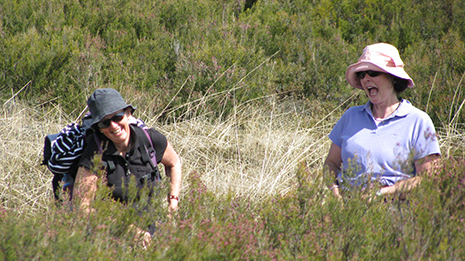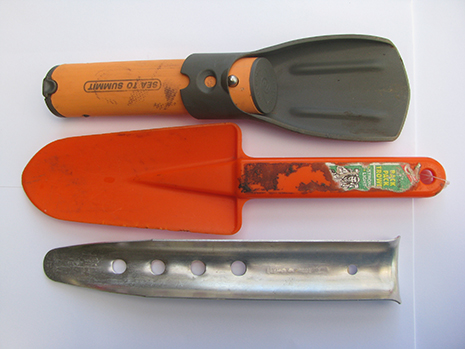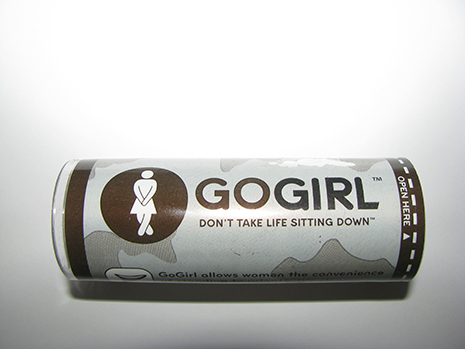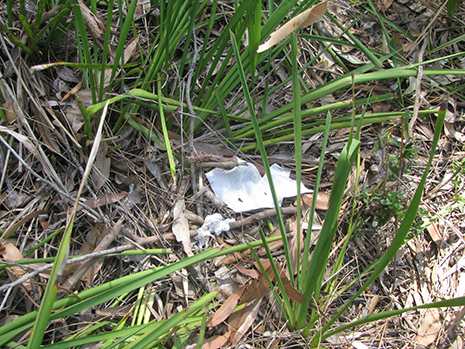By Russell Brown
The first time that I went camping, I was introduced to the somewhat confronting practice of bush toileting in true 1950’s style.
I was faced with a rickety hessian enclosure and inside was a scarily unstable large trench surmounted by a stout stick suspended between two ‘Y’ shaped wobbly supporting sticks. We were instructed to place our juvenile privates on one side of the stout stick and our tiny bottoms on the other side, then to do our business and cover our deposit with a clod of soil or sand. Such shared facilities were referred to as the ‘Latrine’ or the weird acronym: ‘KYBO’ (= Keep your Bowels Open).
Needless to say, the easier option was to ‘put it on hold’ for the rest of the weekend until back home and the comfort and convenience of a stable seat on a flush toilet in a nice shiny tiled private bathroom!
Now, many years older with a much bigger bottom, a little wiser and somewhat more aware, I have engaged in bush toileting in many Australian bush places and in several other countries and am glad to see there is more than one solution to the very basic need to perform these very basic, but essential, human functions.
The traditional and simplest method is to dig a small hole (often called a ‘cat hole’), squat, and leave both your personal deposits and paper deposits in the hole, cover them with soil and then maybe add some leaves so as to neatly disguise the location of your business. Sounds easy but there are a number of options and aspects that should be considered:
- Location of your proposed hole: ideally well away from campsites or walking tracks and at least 100m from the nearest watercourse. Also, despite the convenience of good friable soil or sand, avoid all watercourses, even dry ones, because when the inevitable torrent does come downstream it can unearth everything that you so tidily hid and thus contaminate the water. If available, choose a spot with soft moist soil, preferably away from bothersome tree roots, etc. The bacteria necessary for efficient decomposition are generally found only in the top 10 to 30cm of soil and are almost completely absent in arid soils and very slow-working in very cold climates or in cold seasons. The hole needs to be wide enough and deep enough to accommodate your ‘ahem’, deposit. You also need to be out of sight of fellow campers or passersby so that you can just relax and let it all fall out. Now is not the right time to be the object of that old game: ‘Spot the piddler’!

Bush toileting needs to be private when you are standing up as well as when you are squatting down!
- Digging implement: take a handy, lightweight orange/green/yellow/blue/black plastic cat-hole trowel or a more sophisticated and stronger steel/aluminium/titanium model. Even a good stick, pointy rock or the heel of your boot can suffice so long as your excavation is to the necessary depth and width. A normal garden shovel or entrenching tool (but not an axe!) would be fine if you are travelling by 4WD.

Three types of bush toilet trowels or cat-hole trowels
- Before you squat, think about your clothing. Pants or shorts can be dropped to just around knee level to keep them right out of the firing line. Down around the ankles can be disastrous! So if you find it more convenient (and your location is sufficiently private), clothing below the waist can be removed altogether and placed conveniently aside. Alternatively, loose skirts can be gathered around the waist or decoratively flounced out wide to maintain female modesty.
- Squatting on your heels, like many of my Nepalese friends do for hours on end, can be a very painful or unstable position for some Westerners, particularly those of a certain age like me. Carrying and erecting a small folding stool with a standard toilet seat on top can provide the necessary level of comfort and familiarity when you are car-camping but with lightweight camping there are other innovative strategies that might help. Try leaning your back against a rock or log, or even sitting on a narrow log with legs on one side and bum on the other (thus harking back to my traumatised youth!). Or just try holding onto a a low branch or the trunk of a small tree to take some of the weight off your knees. Some people even find that sitting on two rocks that are just the right distance apart to be very productive.
- Obviously, you need to position yourself correctly to get the deposit into the hole. Not to worry, any misalignments can be easily corrected if there is a handy stick within reach.
- Regardless of whether you are a ‘folder’ or a ‘scruncher’, I would expect your toilet paper (TP) to follow into the hole. Recycled biodegradable paper will decompose more quickly than highly perfumed, embossed, printed and bleached white paper. At all costs, do not use and leave ‘Toilet Wipes’. Even those that are labelled ‘flushable’ have a range of unnecessary biochemicals and have been made to be more durable than standard TP. Some authors will recommend burning the TP which would only be acceptable when there is no fire ban. A better alternative is to pack it out and take it with you, along with any used tampons or sanitary pads. A clip-seal bag inside another bag will be a suitable container — but more of that later! In the unfortunate event that you find yourself without the necessary TP, you can easily (especially when there is no other alternative) resort to the more environmentally conservative practice of using available natural materials such as leaves, sticks, sand, rocks or even gravel. You may want to try this out once or twice before it becomes the only available option!
- Once everything has been deposited in the hole, you could just cover it with soil, tamp it down and then sprinkle leaves around to disguise the location. But there is one more thing that you might consider doing to assist the natural composting process. That is, to stir some of the soil into your poo pile before you fill and cover the whole hole! The composting bacteria work best when they are in full contact with the raw material. A handy stick will be an effective stirrer. It is important to finally cover the hole deeply with soil to reduce the likelihood of it being dug up and TP scattered by animals. The deeper the cover, the better.
- I have to confess I can see two points of view about the recommendation to disguise your personal and intensely private spot. Clearly, leaving as little trace as possible is a very good thing but if suitable locations are in short supply and other happy campers will be out searching, it might be good to leave (X) crossed sticks standing upright in the ground as a warning that no further digging is recommended just there! Over time the stick will rot or fall over and by then the warning may not be needed.
- The final stage of the process is to observe good hygiene practice by washing hands with soap away from any lakes or streams or, as a minimum, use some hand sanitiser solution. You can buy it in small plastic bottles which are light enough to carry when hiking and they can easily be packed together in a bag with your TP and toilet trowel.
‘But surely’ I can hear you say ‘you don’t expect us to dig a hole every time we need to just do a pee?’
‘No I do not’ I reply. As you all would certainly know, there are many differences in Toilet Talk between a Number One and a Number Two.
Now, contrary to popular belief, the urine of healthy people actually does still contain low levels of bacteria, so please think twice about using it for something such as washing a wound in an emergency waterless situation! Letting the wound bleed is a better way to flush out any dirt and it allows the wound to be bathed in good infection-fighting white blood cells.
So, wound washing aside, it is tempting to think that it is OK to pee anywhere in the outdoors because urine is mostly just water and will soak into the soil and leave no trace?
‘Wrong!’
The urine smell can still attract animals that will sometimes dig up the area or eat the plants on which you gaily splashed your pee. It will also, over time, begin to oxidise and, in large concentrations, make a popular pee-spot or campsite very smelly. It will also add unwanted salts to our natural fertiliser-hating Australian vegetation. So the best place to do your pees is on bare rocky or gravelly ground (without mosses, etc that will be killed by urine) or one covered with a thick layer of something like pine needles and to move to a different spot each time to avoid the buildup of the salts and the ammonia smell.
That is all very well for men and boys of all ages who have spent their whole lives knowing that they can just stand and deliver whenever the urge takes them. But for young school-age girls who have never enjoyed the blissful relief of relieving themselves in the bush, it can still be a messy and traumatic experience. I can remember a female teacher supervising a primary school bush walk, and passing the contents of a whole box of tissues to a young girl behind a bush who did not know that, without a toilet to sit on, she would have to squat to prevent the pee running down her legs and into her shoes.
Some agile ladies are able to pull their panties to one side, stand or squat with feet wide apart and direct their pee very easily and conveniently with the minimum of stress, followed by a quick shake and a drip dry. This is not a 21st century development associated with the growth of suburban keep-fit gyms but has been known to be practised by early Greek prostitutes nearly 2500 years ago and was still common practise in certain cultures and situations in 19th Century Europe. On the other hand, the enviable female ability to ‘hover’ over a conventional shared toilet is still in practice today.
But for the likes of female firefighters dressed in protective overalls or females in military uniform, undressing sufficiently to squat and take a leak while at the fire-front or while in combat conditions or on convoy can be a time consuming and vulnerable process.

Example of a Female Urinary Diversion Device (FUDD)
Military research has shown that the dangers for females to take the time to undress and pee has led to cases of dehydration (through not drinking enough so as to reduce the need to pee) and increased risk of urinary tract infections (from saving it up til later!). Some women still suffer similar disincentives when bushwalking and camping today. Fortunately, there is now a Female Urinary Diversion Device (FUDD – catchy name isn’t it?) being introduced by the military to improve the health of the increasing number of females joining the armed forces. There are also several devices with more appealing names (eg ‘Shewee’ and ‘GoGirl’) to enable civilian women to pee while standing up. Again, not such new technology – the first was patented back in 1922! Nowadays they are also becoming useful devices for use by transgender people. Just put ‘Female Urinary Device’ into your favourite search engine and read the reviews, directions and descriptions of more than 25 varieties, worldwide.

Used toilet paper near a popular tourist track
For all the ‘folders’, ’scrunchers’ and ‘dabbers’, there is still the issue of TP (or tissues) of which to to dispose appropriately. How disappointing it is to come across such litter, in such quantities, in such otherwise idyllic hidden and not-so-hidden spots along the popular tracks and trails in our bush. Ladies (and gentlemen too), please … the TP and/or the tissues need to be disposed of properly! As a minimum, scrape away the natural leaves, sticks and stuff and then reposition it all to hide your paperwork and to assist it all to decompose quickly and out of sight.
So for all those who love to commune with nature in the Australian Bush, please go prepared, develop good practices and leave as little trace as possible. The followiong Toilet Talks will cover the development of on-site disposal facilities and the pack-it-out possibilities and practices.

